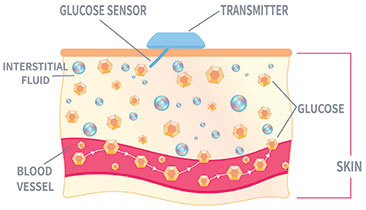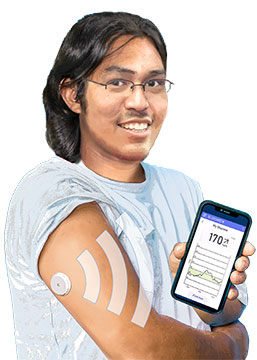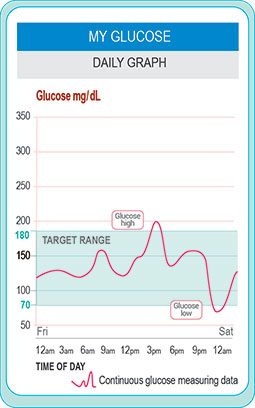Continuous Glucose Monitoring
What is a Continuous Glucose Monitor
Continuous glucose monitors (CGMs) are devices you wear that give you minute-by-minute readings on how glucose (sugar) levels are going up and down. CGMs have alarms to alert you if your sugar goes too high or too low.
CGMs help you understand how diabetes medications (especially insulin), food, exercise, stress, and sick days affect your blood sugar. Understanding your blood sugar patterns may make it easier to reach your target A1c.
Share
View Handout [PDF – 2.6 MB]
How does a CGM work?
Sensor
The CGM sensor is disposable. It uses a thin flexible material, called a filament, to measure sugar in the fluid under your skin. It is held on by an adhesive, allowing you to shower or swim. Most sensors last 10-14 days.

Transmitter
The transmitter is attached to the sensor and sends sugar values to the reader or a smart phone with a CGM application. Using a wireless connection CGMs transmit values every 1-5 minutes.
Reader
A reader displays your sugar levels throughout the day. It is a device about the size of a cell phone. You may be able to view and share the information with those you authorize, such as a family member or your health care provider.

A Sample Continuous Glucose Monitor Data Graph
The CGM data graph shows glucose levels over time. In this example, the target range (usually 70-180 mg/dL) is in green. A sugar target is the number range you try to stay within. This can vary depending on your age and health issues.
CGMs can also show the percentage of time in a day that sugars have been in the target range. Treatment plans can be changed based on the patterns shown in your data graph.
The American Diabetes Association recommends that a person with diabetes aim for a time in range of at least 70 percent of readings (not high or low).

What are some pros and cons of CGM use?
Pros of CGMs
- Continuous sugar readings for care decisions
- No finger sticks
- Alerts for high or low blood sugars
- Notifies caregivers so they can respond
Cons of CGMs
- Possible skin irritation or sensitivity to adhesive
- Sensor may get caught on clothing and come off
- Sensors need to be replaced every 10-14 days
- Transmitters require Internet and Bluetooth connectivity


